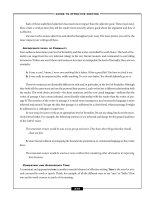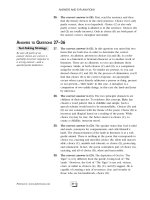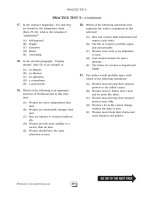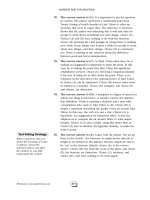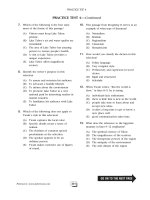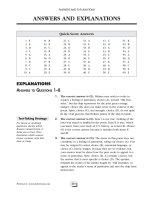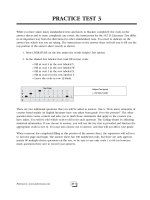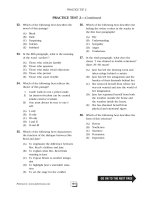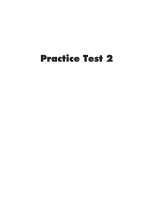SAT II success literature Episode 2 Part 4 docx
Bạn đang xem bản rút gọn của tài liệu. Xem và tải ngay bản đầy đủ của tài liệu tại đây (133.95 KB, 20 trang )
ANSWERS AND EXPLANATIONS
Quick-Score Answers
1. E
2. E
3. D
4. C
5. A
6. B
7. B
8. C
9. C
10. A
11. B
12. E
13. C
14. B
15. A
16. D
17. B
18. E
19. A
20. E
21. C
22. B
23. D
24. B
25. A
26. B
27. C
28. E
29. B
30. B
31. A
32. E
33. B
34. E
35. C
36. E
37. D
38. A
39. B
40. E
41. C
42. D
43. A
44. B
45. C
46. E
47. B
48. A
49. D
50. E
51. B
52. B
53. D
54. A
55. A
56. D
57. A
58. C
59. E
60. E
EXPLANATIONS
ANSWERS TO QUESTIONS 1–8
1. The correct answer is (E). Holmes may wish to evoke in
readers a feeling of patriotism, choice (A), toward “Old Iron-
sides,” but the ship represents for the poet great courage.
Danger, choice (B), does not make sense in the context of the
poem. Spirit, choice (C), and strength, choice (D), do not quite
fit the vivid pictures that Holmes paints of the ship in battle.
Test-Taking Strategy
For tiered or multistep
questions, decide which
Roman numeral item or
items are correct. Then
determine which answer
choice contains only that
item or items.
2. The correct answer is (E). Item I is not true. Nothing of the
kind was stated or implied in the poem. Item II is true, which
you know from your study of U.S. history, as is item III. Choice
(E) is the correct answer because it includes both items II
and III.
3. The correct answer is (D). The meter in this poem does not
contribute to a feeling of patriotism, ruling out choice (A). You
may be tempted to select choice (B), emotional language, or
choice (C), heroic images, because they are in evidence, but
your answer must be about how the poet seeks to appeal to a
sense of patriotism. Style, choice (E), is certainly a factor, but
the answer that is most specific is choice (D). The speaker
reminds the reader of the battles fought by “Old Ironsides” to
appeal to the reader’s sense of patriotism and save the ship from
destruction.
ANSWERS AND EXPLANATIONS
231Peterson’s: www.petersons.com
4. The correct answer is (C). The key to answering this question
correctly is the word not. You must identify the image that does
not represent battle. Phrases such as “red with heroes’ blood”
and “vanquished foes” suggest war, so choice (A) is true about
the poem and not the correct answer. Cannons roar, choice (B),
and “battle shout,” choice (D), also suggest warfare and can be
ruled out, as can choice (E) with its images of “victor’s tread”
and “conquered knee.” That leaves choice (C) as the correct
answer. The “harpies of the shore” relate to those who would
demolish the battleship.
Test-Taking Strategy
For not/except questions, ask
yourself if the answer is true
in the context of the selec-
tion. If it is, cross it off and
go on to the next answer
choice.
5. The correct answer is (A). Read the poem carefully and
consider the words and the purpose of the poem. You will find
that it is passionate, choice (B); eloquent, choice (C); rousing,
choice (D); and stirring, choice (E). The poem really does not
chide, that is, mildly rebuke, choice (A), so that is the correct
answer.
6. The correct answer is (B). Item I is incorrect. The reader is
not given information concerning the politics of this situation.
That rules out choices (A), (D), and (E). Item III is a little bit
true, because the writer hopes that if enough people are
inspired, their patriotism will cause them to act, and the ship
will not be demolished. The question stem, however, uses the
qualifying word primary. Holmes’ primary goal is to save “Old
Ironsides.” This makes item II the only correct response and
choice (B) the answer.
7. The correct answer is (B). The words like and as are not
present, so eliminate choice (D), simile. Eliminate choice (E),
metonymy, in which an object, a person, or an idea is used to
represent something with which it is associated. There is no
evidence of that in the line or in the lines around it. Although
one could say that the image is an exaggeration, it does not fit
the definition of hyperbole, choice (C), which is a deliberate
exaggeration to create humor. While personification, choice (A),
may be an appealing response, eliminate it also. Personification
attributes human characteristics to inanimate or nonhuman
objects. The eye is not an inanimate object. That leaves choice
(B), vivid detail. Holmes studs the poem with vivid images such
as “tattered ensign,” “meteor of the ocean,” and “set every
threadbare sail.”
SAT II SUCCESS: LITERATURE
232 Peterson’s SAT II Success: Literature
Review Strategy
See A Quick Review of
Literary Terms, chapter 4.
8. The correct answer is (C). Rule out choice (E), sonnet,
immediately, because the selection is not a 14-line poem written
in iambic pentameter. The poem does not tell a story, choice
(D), nor is it about death, an elegy, choice (B). It is not an ode,
choice (A), a lengthy poem written to praise. It is a lyric poem,
choice (C), a short, melodic, subjective poem, expressing the
thoughts and feelings of a single speaker.
ANSWERS TO QUESTIONS 9–18
Test-Taking Strategy
Go back and check the
passage. Don’t rely on what
you think it says.
9. The correct answer is (C). The word pilgrim refers to a
traveler journeying to a sacred place, not an English colonist to
New England. That denotation eliminates choice (A). The word
vanity in the subtitle serves as a clue indicating that the fair is
not an ordinary English fair, thus ruling out choice (B). The
word progress suggests travel, but not necessarily the explora-
tion of unknown places, choice (D). Although the selection ends
with a humiliating experience, choice (E), that is not suggested
by the title. The title implies religious subject matter and sin,
choice (C).
10. The correct answer is (A). You can eliminate choices (C) and
(E) immediately because nothing in the work suggests Eastern
religious beliefs, Nirvana, or a holiday marketplace. There is
mention of a trial, choice (D), and imprisonment, choice (B), but
those are elements of the plot. The setting is a fair in a corrupt
and avaricious land.
11. The correct answer is (B). The selection does tell a story,
choice (A), but it does more than that. The selection does not
focus on romantic love or heroic achievements as would a
romance, choice (C). It is not told from the narrative perspective
of one character in a stream of consciousness, choice (D). There
is no mystery, horror, or the supernatural, characteristics of
Gothic prose, choice (E). The selection is from an extended
narrative in which characters, events, and settings represent
abstract qualities and have a second meaning, often religious or
moral, to be read beneath the surface story, choice (B), an
allegory.
ANSWERS AND EXPLANATIONS
233Peterson’s: www.petersons.com
12. The correct answer is (E). You can eliminate choices (A) and
(D) because they are contrary to the writer’s message. Choice
(A) claims that all people can be corrupted, and clearly the
pilgrims are not corrupted by their surroundings. But then the
life experiences of the people of the fair have not led them to
spiritual growth, so choice (D) is also incorrect. Choice (C) is
not evident in the selection, so it can be ruled out. Choice (B)
has some validity, but the better, more specific response is
choice (E). Choice (B) is a detail that supports choice (E).
Test-Taking Strategy
Read questions carefully so
you won’t miss key words.
Underline, circle, or bracket
key words as you read the
question stem to help you
concentrate on what you
should be looking for among
the answer choices.
13. The correct answer is (C). The key to this question is the
word not. You must find which of the responses does not apply
to this selection. If you did not know the answer immediately,
you could try educated guessing. Because the work is an
allegory, you know that there is allusion, choice (A), and
symbolism, choice (B). The excerpt has several pieces of
dialogue, choice (E), and many vivid details, choice (E). An epic
simile, choice (C), an extended, elaborate, ornate comparison
usually associated with poetry, does not exist in the selection.
14. The correct answer is (B). This question requires an under-
standing of the writer’s message and allegory. Choice (A), the
way out of the fair, is much too literal. Choices (C) and (D) are
distracters; they sound weighty and solemn to match the piece,
but the selection does not support either idea. Choice (E) is
contrary to the theme and content of the selection. That leaves
choice (B) as the correct answer.
15. The correct answer is (A). The climax is usually the crisis or
turning point, the time of most intensity in a piece. Except for
the correct response, all the answer choices—the hubbub,
choice (B); the examination of the pilgrims, choice (C); the
beating of the pilgrims, choice (D); and the fact that the
townspeople think them insane, choice (E)—result from the
climax. The pilgrims’ answer, choice (A), sets this chain of
events in motion.
SAT II SUCCESS: LITERATURE
234 Peterson’s SAT II Success: Literature
16. The correct answer is (D). If you did not know that carriage
means how one holds the head and body, in other words, a
person’s posture, you could use elimination to find the correct
choice. Sometimes the most obvious answer is the correct
answer, but not this time. There is no indication that the
pilgrims are using any vehicles, so rule out choice (A). A
misreading of who is speaking in line 8 might confuse you into
selecting choice (C), but there is no indication of how the
merchants are showing and selling their wares. Although line 19
mentions the pilgrims’ “unusual garb,” that is not the meaning of
carriage, so eliminate choice (B). You might think that chariot,
choice (E), is a biblical allusion to God’s chariot, but there is no
such allusion or implication in the allegory.
17. The correct answer is (B). There is a subtle distinction here.
The writer uses vivid description, choice (A), to explain the
growing hostility of the people at the fair. But choice (B),
documenting that hostility, is the way the writer builds sus-
pense. Choice (C), the introduction of avaricious people, does
not build suspense; those characters serve as antagonists. Sound
images, choice (D), and Biblical allusions, choice (E), do not
build suspense.
18. The correct answer is (E). The writer uses all three—detail,
action, and dialogue—to develop the characters. The correct
answer reflecting all three is choice (E).
ANSWERS TO QUESTIONS 19–25
19. The correct answer is (A). The definition of a dramatic poem
is one in which one or more characters speak, and the words of
each speaker are usually enclosed in quotation marks. That
means item I is correct in relation to this poem. The rhyme
scheme, item II, and/or the meter, item III, are not determining
factors in dramatic poetry. Therefore, choices (B), (C), (D), and
(E), all of which contain one of the incorrect items, are wrong.
Review Strategy
See A Quick Review of
Literary Terms, chapter 4.
20. The correct answer is (E). The word shadow means area of
shade, choice (D), in the first verse; sadness, choice (A), in the
second verse; and dominant influence, choice (C), in the fourth
stanza. Choice (B), disconsolation, is synonymous with sadness.
The shadow in verse three is an apparition, choice (E).
21. The correct answer is (C). Choice (A), the Lord’s Prayer, is a
distracter. Choice (B), a valley in the late afternoon, is too literal.
Choices (D), a haunted place, and (E), Eldorado itself, do not
work in the context of the poem.
ANSWERS AND EXPLANATIONS
235Peterson’s: www.petersons.com
22. The correct answer is (B). Choices (C), (D), and (E) are
irrelevant to the poem and serve as distracters. Eldorado is a
legendary city of gold, choice (A), that no one has ever found.
It, therefore, has come to symbolize an unreachable goal, choice
(B), the correct response.
23. The correct answer is (D). You can immediately discard
choice (E) because it restates the question. Both choices (A) and
(B) are simply wrong. The knight does not find Eldorado and
there is nothing realistic about the dialogue. While some might
consider the conversation terrifying and chilling, choice (C), the
better answer is choice (D) because it describes the meaning of
the dialogue, not simply its effect. The knight learns that he will
never attain his goal in this life.
24. The correct answer is (B). Choice (A) is incorrect because the
knight met the shadow in stanza three. The knight is joyful only
in the first stanza, so choice (C) is incorrect. Choice (D) is
incorrect; the change creates a discordant effect rather than
enhancing the musicality of the poem. Choice (E) may sound
knowledgeable, but it is illogical. Changing rhyme scheme is not
idiosyncratic in itself or to Poe. Choice (B) is the correct answer;
the change signals the importance of the last stanza.
Test-Taking Strategy
All parts of a response must
be valid for the choice to be
correct.
25. The correct answer is (A). This question is easy if you
remember figures of sound. Each pair except the right answer
has one figure of speech that is not a sound device. Hyperbole
in choice (C), simile in choice (D), and metaphor in choice (E)
are not sound devices. The three are figures of speech. This fact
means you can easily eliminate choices (C), (D), and (E). An
affricate in choice (B) is a sound that begins with a stop, used in
classifying consonant sounds. It is not a sound device, so discard
choice (B), too. Alliteration, the repetition of consonant sounds
at the beginning of words that are close to one another, and
assonance, the repetition of vowel sounds between different
consonants, are both sound devices, making choice (A) correct.
SAT II SUCCESS: LITERATURE
236 Peterson’s SAT II Success: Literature
ANSWERS TO QUESTIONS 26–36
Review Strategy
See A Quick Review of
Literary Terms, chapter 4.
26. The correct answer is (B). This poem is not an ode, choice
(A), a long lyric poem, usually written to praise someone. Nor is
it an elegy, choice (C), a poem about death or mortality. It is not
an epic, choice (D), a very long narrative poem. A quick count
of the lines will tell you that it has sixteen lines, ruling out
choice (E), sonnet, a poem of fourteen lines. It is clearly a lyric
poem, choice (B), a short, imaginative, personal kind of poem,
expressing the thoughts of one speaker.
27. The correct answer is (C). Rule out choice (A), alliteration, as
there is no evidence of repeated initial consonants. Choice (B),
consonance, is incorrect, because there is no repetition of
identical initial and final consonant sounds. Euphony, choice (D),
a succession of harmonious sounds can also be eliminated.
Choice (E), oxymoron, can be ruled out because there is no use
of contradictory words or phrases in the stanza. That leaves
choice (C), repetition, which Blake uses very effectively in the
first four lines.
28. The correct answer is (E). Sensory images, both visual and
aural, are found throughout the poem, ruling in choice (A). In
the second, third, and fourth stanzas, there are important
symbols, (“Man,” “Infant”), ruling in choice (B). The meter is
indeed rhythmical, choice (C), and the language is emotional
(“woe,” “cry,” “blood”), choice (D), leaving choice (E), intellec-
tual appeal, as the exception. This poem was not written to
appeal to the intellect; it was written to appeal to the emotions.
29. The correct answer is (B). Note the words cry, sigh, voice,
hear curse, and blasts. These are aural images appealing to the
reader’s sense of hearing. No images that appeal to the other
senses are used, eliminating choices (A), (C), (D), and (E).
Test-Taking Strategy
If you don’t know the
answer immediately, use the
educated-guessing technique
to help you choose the right
answer.
30. The correct answer is (B). The poem is in sonnet form; the
octet refers to England and the sestet to Milton, so all the
references to Milton are in the final sestet, lines 9 through 14.
This makes choices (A), (C), (D), and (E) wrong answers to the
question. Choice (B) is part of an enumeration of those parts of
English life that have lowered their standards and lost the
essence of their “Englishness”; the references are specifically to
the church, the military, and intellectuals.
ANSWERS AND EXPLANATIONS
237Peterson’s: www.petersons.com
31. The correct answer is (A). The poet is indeed yearning for an
England of times past, for a return to the kind of England that
Milton knew. Choice (B), melancholy; choice (C), plaintive; and
choice (D), lugubrious, can be eliminated. The tone may be a bit
sad, or even very sad, but the connotations of these words do
not quite capture the overall tone. Choice (E) is ruled out
because the poem appeals more to the intellect than to the
emotions. Choice (A) is the best answer.
Test-Taking Strategy
Read all the choices before
you choose your answer. A
snap judgment could cost
you a quarter point.
32. The correct answer is (E). Did you jump at choice (A)? This
question calls for a careful reading. The first line of the poem
does not contain an allusion, choice (A), which is a reference to
another work or a famous figure. The author calls out to Milton
in this line, making it an example of apostrophe, choice (E), the
device of calling out to a dead or imaginary person. Even if you
were not sure, you could work your way through the answers to
this one. The first line is not an allegory, choice (B), because it
cannot be an extended narrative having a surface meaning and a
second underlying meaning. Neither is it an analogy, choice (C),
a comparison of two similar but different things. The line also is
not an aphorism, choice (D), a short, witty statement of a
principle.
33. The correct answer is (B). Read the answer choices in
context, substituting each choice into the line. Read around the
cited line as well. The word stagnant in line 3 is a clue.
Although each of the choices could reasonably be substituted,
you must read a little deeper and make judgments based on the
style of the author and his attitude toward and concern about
London. It is unlikely that Wordsworth would compare his
beloved London to something as mundane as a barrel, choice
(A), or a trough, choice (D), or so small as a puddle, choice (E).
Most lakes are clear, not stagnant, ruling out choice (C). That
leaves choice (B), a bog, or marsh, which fits the context.
Review Strategy
See A Quick Review of
Literary Terms, chapter 4.
34. The correct answer is (E). In not/except questions, you are
looking for what is not true about or present in the selection.
Metaphor, choice (A), and simile, choice (B), are easily identified
in the poem. The author compares England to a fen, line 2, and
says Milton’s soul is “like a star,” line 9. England is personified as
an individual whom Milton is called upon to help, ruling out
choice (C). Alliteration, choice (D), is found in line 9, eliminat-
ing it. The exception is choice (E), synecdoche, a figure of
speech in which a part of something is used to represent the
whole, such as using “wheels” to mean a “car.”
SAT II SUCCESS: LITERATURE
238 Peterson’s SAT II Success: Literature
35. The correct answer is (C). Rule out the answers that mean the
poems are different, rule in the answer that means that the
poems are alike in that aspect. The forms of the poem differ;
Blake is more accessible to the reader, while Wordsworth is
more formal, ruling out choice (A). Their tones are different;
Blake is emotional, and Wordsworth is yearning in an intellectual
manner, ruling out choice (B). Choice (D) is eliminated because
Blake uses many sensory images, while Wordsworth does not.
Choice (E) is ruled out because Blake uses repetition and
assonance, while Wordsworth uses hardly any sound devices.
Only choice (C), their purpose, is the same—to address what
they perceive as the spiritual and physical deterioration of
London.
36. The correct answer is (E). Read both poems carefully. All of
the items, I, II, and III, are true. Thus, the correct answer is
choice (E) because it includes all three items.
ANSWERS TO QUESTIONS 37–45
37. The correct answer is (D). You can eliminate choice (A)
because you as the reader can easily recognize that the advice is
facetious. Choice (B), to cause laughter among children, is
implausible because the vocabulary is too sophisticated for
children. If this “advice” were put into practice, conflict, choice
(C), would escalate, not be resolved. Choice (E) cannot be
correct because the person addressed, “you,” refers to little girls,
not parents. The selection does comment on human nature and
behavior, choice (D).
38. The correct answer is (A). If you read this piece critically, this
question should be easy. This selection is not fiction, choice (B),
amusing though it is. The work purports to be informative,
choice (C), but is actually comical, eliminating this answer. The
writer does not try to convince readers or call them to action, so
choice (D), persuasive essay, is eliminated. A prose poem, (E), is
a distracter. If the piece is not fiction and is amusing, then
choice (A), humorous essay, is the correct answer.
39. The correct answer is (B). Choice (A) contradicts the theme
of the essay, satirical advice about girls’ behavior; this is not
good advice. Only the first sentence of the quotation—showing
respect to the aged—is reflected in choice (C). Choice (D)
misstates the first sentence of the quotation by saying “the lines”
elaborate on the idea that it is all right to retaliate. Choice (E) is
inaccurate in the context of the piece and too general.
ANSWERS AND EXPLANATIONS
239Peterson’s: www.petersons.com
40. The correct answer is (E). The selection has paragraphs in
which choices (A), (B), (C), and (D) are suggested. However, the
conflict presented for the entire passage is that of girls against
convention and society’s rules, choice (E).
Test-Taking Strategy
Be sure you are consistent in
your answers for a selection.
Remembering how you
worked your way through
the answers for question 37
will help you get this one
right.
41. The correct answer is (C). To determine the correct response,
ask yourself, to whom is the writer giving advice. The title and
the context of the passage provide the answer, little girls, choice
(C).
42. The correct answer is (D). Item I, second person point of
view, and item II, folksy language, are both elements of Twain’s
style in this passage. Satire, item III, is not because, while this
passage is humorous, it does not have a critical attitude. There-
fore, you can discard choices (A), (B), (C), and (E); only choice
(D) has the two correct Roman numeral items.
43. The correct answer is (A). You can immediately eliminate
choice (C), lyrical, and choice (E), clinical, because neither has
any relation to the passage. The essay is not ridiculing, choice
(B), or admonishing, another word for reproving, choice (D). It
is tongue in cheek, choice (A), meaning humorous. Here, the
answer for question 38 should have helped you.
44. The correct answer is (B). The words, general, choice (D),
and periodic, choice (E), do not refer to types of diction, so
those can be easily eliminated. Formal, or high, diction, choice
(A), consists of standard and elegant words, absolutely proper
grammar, and no contractions. Eliminate choice (A). Informal
diction, choice (C), includes slang vocabulary, substandard
grammar, and idioms. That is not Twain in this selection, so
eliminate choice (C). Neutral, or middle, diction, choice (B),
includes ordinary everyday vocabulary, occasional contractions,
and some flexible grammar. Words like sass and sentences
beginning with coordinating conjunctions indicate neutral
diction, so choice (B) is the answer.
SAT II SUCCESS: LITERATURE
240 Peterson’s SAT II Success: Literature
ANSWERS TO QUESTIONS 46–51
45. The correct answer is (C). The final two responses can be
discarded because choice (D) is the opposite of the cited phrase
and choice (E) is illogical. Fiction means something made up. It
could mean a story, choice (A), or a piece of prose, choice (B).
But in the context of the passage, choice (C), a really convincing
lie, is the best answer.
Review Strategy
See A Quick Review of
Literary Terms, chapter 4.
46. The correct answer is (E). This poem cannot be a sonnet,
choice (A), because it has sixteen lines. This poem is not long,
elaborate, or written in praise of someone or something, all
essential elements of an ode, choice (B). Free verse, choice (C),
has little or no rhyme or meter; this poem has both. An elegy,
choice (D), is a poem about death or mortality, a feeling that is
diametrically opposed to this piece.
47. The correct answer is (B). The four similes in the first stanza
compare Rossetti’s feelings with things in nature to create an
uplifting, rapturous feeling. The images are not about the beauty
of nature itself, choice (A). Giddy tenderness, choice (C), means
a feeling of love that makes one dizzy or puts one in a whirl.
Choice (C) then can be eliminated because the emotions
communicated in the poem are deeper than that. Expectation,
choice (E), is also not deep enough. Melancholy, choice (D), is
the opposite emotion to what is intended in the poem.
48. The correct answer is (A). You should recognize Christina
Rossetti as a Pre-Raphaelite poet who was thus interested in the
spiritual and religious. This poem has a deeply religious mean-
ing. There is nothing in the poem to indicate a fiancé, choice
(B). Choice (C), anticipation of a celebration, and choice (D),
appreciation of luxury, are too literal. The wonder of nature,
choice (E), is present in the poem to serve as comparisons to
the speaker’s joy. The poet is ecstatic because she has found the
religious force central in her life, choice (A).
49. The correct answer is (D). Choice (A), musicality, and choice
(C), cadence, are elements of style and the poet’s technique.
They are not relevant to the question, which asks about mood.
The mood is anything but vague and languid, choice (B).
Suspense, choice (E), is not an element in this poem. It is more
likely to be found in narrative poetry. That leaves choice (D),
reinforcing the sense of ecstasy, as the correct answer.
ANSWERS AND EXPLANATIONS
241Peterson’s: www.petersons.com
50. The correct answer is (E). The poet uses parallel construction
in lines 1, 3, 5, and 7, so item I is correct. Similes are present in
the first stanza in lines 1, 3, and 5, making item II correct. Vivid
imagery, item III, is used extensively in both stanzas, so item III
is also correct. Choice (E), which includes all three items, is the
correct answer.
51. The correct answer is (B). The question prompt uses the
phrase “word picture.” Musicality results from figures of sound,
so choice (A), clear musical images, does not work. There are no
allusions to the Renaissance, choice (C). A rainbow shell and a
singing bird, choice (D), are in the first, not the second, stanza.
The tone of the poem is ecstatic, not romantic, choice (E).
ANSWERS TO QUESTIONS 52–60
Study Strategy
Have a dictionary with you
when you read so you can
look up unfamiliar words.
This will enhance your
understanding of what you
are reading and may
improve your test score.
52. The correct answer is (B). The use of educated guessing can be
useful in determining the correct answer to this question. Ask
yourself if the selection is amusing. Possibly, but is that the over-
riding tone? No, it is more pointed than if it were simply to make
someone laugh, so discard choice (A). Is the excerpt satirical and
acerbic? Yes, so choice (B) is correct, but continue reading
through the answers to make sure it is the best choice. Is the se-
lection objective? No, just because it talks about facts doesn’t
make it factual and unbiased, choice (C). That also rules out
choice (D). Because it is satirical, the description is certainly bi-
ased. Choice (E), laudatory, is the opposite of what Dickens in-
tended, so it is incorrect. Choice (B) is the correct answer after all.
53. The correct answer is (D). This is one of those questions
where on first reading you may think that several of the answers
are correct. First, eliminate whatever you can. Choice (B),
hyperbole, can be eliminated because this was ruled out in
question 52. Choice (C), stream of consciousness, can be ruled
out because the reader is not placed within the mind of the
character, in this case, the speaker. While the point of view that
Dickens chose was limited omniscient narrator, choice (A),
Dickens does not use it in any special way to heighten its
effectiveness, so rule out choice (A). That leaves choices (D) and
(E), and both seem very plausible. But parallel structure, choice
(E), is the use of a series of words, phrases, or clauses to appeal
to the sense of logic of the reader and to create a rhythm to
what is written or spoken. Repetition, choice (D), on the other
hand, is meant to provide emphasis to what is written or said.
Choice (D) is the better choice because the repetition of the
main clause emphasizes Dickens’s description of the character.
SAT II SUCCESS: LITERATURE
242 Peterson’s SAT II Success: Literature
54. The correct answer is (A). In each of these paired answers try
to identify one portion as being incorrect. If one part is wrong,
the entire answer is wrong. The speaker is neither open-minded,
choice (B), nor warm, choice (C). Based on the “facts” given to
you, it is impossible to determine if he is educated, choice (D),
or scholarly, choice (E). He does come across, however, as both
opinionated and intransigent, or unmovable, choice (A).
Test-Taking Strategy
Always be sure to read a
couple of lines around the
cited word or line to make
sure you understand its
context.
55. The correct answer is (A). If you do not know the meaning of
the word commodious, this can be a difficult question because
several of the responses contain the feeling toward the speaker
that the author wants to evoke in you, the reader. Although the
character is certainly not friendly, choice (D), he could be
described as foreboding, choice (B); serious, choice (C); or dark,
choice (E). These are subjective expressions about the character,
but the author is creating a straightforward description of the
character’s eye sockets—they are spacious or large, choice (A).
56. The correct answer is (D). You may find a question or two
about sentence structure on the test, but don’t expect them to
be based on simple sentence structure. In this example, restate
the clause so that it reads: “The speaker, and the schoolmaster,
and the third grown person swept their eyes (over) the
inclined plane of little vessels ”Itthen becomes clear that
the phrase is the indirect object of the sentence, choice (D).
57. The correct answer is (A). A metaphor compares two unlike
things without using like or as. Choice (B) does not compare
two things; it simply explains some movement. Choices (C) and
(D) are straightforward statements of the man’s belief; there is
no comparison present in either. Choice (E) is a description
using some imagery but without using a comparison. In choice
(A), the speaker’s head is compared to a “plantation of firs,” thus
making it an example of metaphor.
Test-Taking Strategy
Consistency will help you
answer questions correctly. If
you come across a similar
question in a set of ques-
tions, go back and check
your first answer.
58. The correct answer is (C.) Question 52 will help you in
answering this question correctly. In questions that ask you to
make an inference, it is useful to think of the overall tone or
feeling of the excerpt. For example, is the feeling that Dickens
evokes in you of the speaker a positive one or a negative one? In
this case you would have to say negative; therefore, choices (A)
(B), and (D) can be eliminated. Choice (E) is wrong not only
because the image is positive but also because his education is
not mentioned in the passage.
ANSWERS AND EXPLANATIONS
243Peterson’s: www.petersons.com
59. The correct answer is (E). The description of the man in the
second paragraph begins with the top of his head and moves
down. That is spatial order. The paragraph does not begin with
the least important idea and conclude with the most important
one, order of importance, choice (A). Events are not ordered
according to time, choice (B). Some analogies are used, but the
paragraph is not based on comparisons, so choice (C) is incor-
rect. Nor does the paragraph move logically from one point to
another, developmental order, choice (D).
Test-Taking Strategy
The key word is not.
60. The correct answer is (E). This question tests your recognition
of elements of style. If you noticed the word not, you would
have been looking for the response that is not an aspect of
Dickens’ style. A great deal of vivid language and figures of
speech are present, so choice (A) is true and must be discarded.
Repetition, choice (B), and alliteration, choice (D), appear
extensively in the second paragraph, so you can eliminate those
responses. Sentences are long and complicated, so you can
reject choice (C). There are no colloquialisms in this passage; in
fact the language is formal. Therefore, choice (E) answers the
question.
SAT II SUCCESS: LITERATURE
244 Peterson’s SAT II Success: Literature
Practice Test 4
ANSWER SHEET
Leave any unused
answer spaces blank.
Test Code
V
ÞO
1
ÞO
2
ÞO
3
ÞO
4
ÞO
5
ÞO
6
ÞO
7
ÞO
8
ÞO
9
W ÞO
1
ÞO
2
ÞO
3
ÞO
4
ÞO
5
ÞO
6
ÞO
7
ÞO
8
ÞO
9
X ÞO
1
ÞO
2
ÞO
3
ÞO
4
ÞO
5
Y ÞO
A
ÞO
B
ÞO
C
ÞO
D
ÞO
E
Q ÞO
1
ÞO
2
ÞO
3
ÞO
4
ÞO
5
ÞO
6
ÞO
7
ÞO
8
ÞO
9
Subject Test (print)
FOR ETS
USE ONLY
R/C W/S1 FS/S2 CS/S3 WS
1 O
A
O
B
O
C
O
D
O
E
2 O
A
O
B
O
C
O
D
O
E
3 O
A
O
B
O
C
O
D
O
E
4 O
A
O
B
O
C
O
D
O
E
5 O
A
O
B
O
C
O
D
O
E
6 O
A
O
B
O
C
O
D
O
E
7 O
A
O
B
O
C
O
D
O
E
8 O
A
O
B
O
C
O
D
O
E
9 O
A
O
B
O
C
O
D
O
E
10 O
A
O
B
O
C
O
D
O
E
11 O
A
O
B
O
C
O
D
O
E
12 O
A
O
B
O
C
O
D
O
E
13 O
A
O
B
O
C
O
D
O
E
14 O
A
O
B
O
C
O
D
O
E
15 O
A
O
B
O
C
O
D
O
E
16 O
A
O
B
O
C
O
D
O
E
17 O
A
O
B
O
C
O
D
O
E
18 O
A
O
B
O
C
O
D
O
E
19 O
A
O
B
O
C
O
D
O
E
20 O
A
O
B
O
C
O
D
O
E
21 O
A
O
B
O
C
O
D
O
E
22 O
A
O
B
O
C
O
D
O
E
23 O
A
O
B
O
C
O
D
O
E
24 O
A
O
B
O
C
O
D
O
E
25 O
A
O
B
O
C
O
D
O
E
26 O
A
O
B
O
C
O
D
O
E
27 O
A
O
B
O
C
O
D
O
E
28 O
A
O
B
O
C
O
D
O
E
29 O
A
O
B
O
C
O
D
O
E
30 O
A
O
B
O
C
O
D
O
E
31 O
A
O
B
O
C
O
D
O
E
32 O
A
O
B
O
C
O
D
O
E
33 O
A
O
B
O
C
O
D
O
E
34 O
A
O
B
O
C
O
D
O
E
35 O
A
O
B
O
C
O
D
O
E
36 O
A
O
B
O
C
O
D
O
E
37 O
A
O
B
O
C
O
D
O
E
38 O
A
O
B
O
C
O
D
O
E
39 O
A
O
B
O
C
O
D
O
E
40 O
A
O
B
O
C
O
D
O
E
41 O
A
O
B
O
C
O
D
O
E
42 O
A
O
B
O
C
O
D
O
E
43 O
A
O
B
O
C
O
D
O
E
44 O
A
O
B
O
C
O
D
O
E
45 O
A
O
B
O
C
O
D
O
E
46 O
A
O
B
O
C
O
D
O
E
47 O
A
O
B
O
C
O
D
O
E
48 O
A
O
B
O
C
O
D
O
E
49 O
A
O
B
O
C
O
D
O
E
50 O
A
O
B
O
C
O
D
O
E
51 O
A
O
B
O
C
O
D
O
E
52 O
A
O
B
O
C
O
D
O
E
53 O
A
O
B
O
C
O
D
O
E
54 O
A
O
B
O
C
O
D
O
E
55 O
A
O
B
O
C
O
D
O
E
56 O
A
O
B
O
C
O
D
O
E
57 O
A
O
B
O
C
O
D
O
E
58 O
A
O
B
O
C
O
D
O
E
59 O
A
O
B
O
C
O
D
O
E
60 O
A
O
B
O
C
O
D
O
E
61 O
A
O
B
O
C
O
D
O
E
62 O
A
O
B
O
C
O
D
O
E
63 O
A
O
B
O
C
O
D
O
E
64 O
A
O
B
O
C
O
D
O
E
65 O
A
O
B
O
C
O
D
O
E
66 O
A
O
B
O
C
O
D
O
E
67 O
A
O
B
O
C
O
D
O
E
68 O
A
O
B
O
C
O
D
O
E
69 O
A
O
B
O
C
O
D
O
E
70 O
A
O
B
O
C
O
D
O
E
71 O
A
O
B
O
C
O
D
O
E
72 O
A
O
B
O
C
O
D
O
E
73 O
A
O
B
O
C
O
D
O
E
74 O
A
O
B
O
C
O
D
O
E
75 O
A
O
B
O
C
O
D
O
E
76 O
A
O
B
O
C
O
D
O
E
77 O
A
O
B
O
C
O
D
O
E
78 O
A
O
B
O
C
O
D
O
E
79 O
A
O
B
O
C
O
D
O
E
80 O
A
O
B
O
C
O
D
O
E
81 O
A
O
B
O
C
O
D
O
E
82 O
A
O
B
O
C
O
D
O
E
83 O
A
O
B
O
C
O
D
O
E
84 O
A
O
B
O
C
O
D
O
E
85 O
A
O
B
O
C
O
D
O
E
86 O
A
O
B
O
C
O
D
O
E
87 O
A
O
B
O
C
O
D
O
E
88 O
A
O
B
O
C
O
D
O
E
89 O
A
O
B
O
C
O
D
O
E
90 O
A
O
B
O
C
O
D
O
E
91 O
A
O
B
O
C
O
D
O
E
92 O
A
O
B
O
C
O
D
O
E
93 O
A
O
B
O
C
O
D
O
E
94 O
A
O
B
O
C
O
D
O
E
95 O
A
O
B
O
C
O
D
O
E
96 O
A
O
B
O
C
O
D
O
E
97 O
A
O
B
O
C
O
D
O
E
98 O
A
O
B
O
C
O
D
O
E
99 O
A
O
B
O
C
O
D
O
E
100 O
A
O
B
O
C
O
D
O
E
246 Peterson’s SAT II Success: Literature
PRACTICE TEST 4
While you have taken many standardized tests and know to blacken completely the ovals on the
answer sheets and to erase completely any errors, the instructions for the SAT II: Literature Test differ
in an important way from the directions for other standardized tests. You need to indicate on the
answer key which test you are taking. The instructions on the answer sheet will tell you to fill out the
top portion of the answer sheet exactly as shown.
1. Print LITERATURE on the line under the words Subject Test (print).
2. In the shaded box labeled Test Code fill in four ovals:
—Fill in oval 3 in the row labeled V.
—Fill in oval 1 in the row labeled W.
—Fill in oval 1 in the row labeled X.
—Fill in oval D in the row labeled Y.
—Leave the ovals in row Q blank.
Test Code
V
ÞO
1
ÞO
2
Þ ÞO
4
ÞO
5
ÞO
6
ÞO
7
ÞO
8
ÞO
9
W Þ ÞO
2
ÞO
3
ÞO
4
ÞO
5
ÞO
6
ÞO
7
ÞO
8
ÞO
9
X Þ ÞO
2
ÞO
3
ÞO
4
ÞO
5
Y ÞO
A
ÞO
B
ÞO
C
Þ ÞO
E
Q ÞO
1
ÞO
2
ÞO
3
ÞO
4
ÞO
5
ÞO
6
ÞO
7
ÞO
8
ÞO
9
Subject Test (print)
LITERATURE
There are two additional questions that you will be asked to answer. One is “How many semesters of
courses based mainly on English literature have you taken from grade 10 to the present?” The other
question lists course content and asks you to mark those statements that apply to the courses you
have taken. You will be told which ovals to fill in for each question. The College Board is collecting
statistical information. If you choose to answer, you will use the key that is provided and blacken the
appropriate ovals in row Q. You may also choose not to answer, and that will not affect your grade.
When everyone has completed filling in this portion of the answer sheet, the supervisor will tell you
to turn the page and begin. The answer sheet has 100 numbered ovals, but there are only approxi-
mately 60 multiple-choice questions on the test, so be sure to use only ovals 1 to 60 (or however
many questions there are) to record your answers.
247Peterson’s: www.petersons.com
Directions: This test consists of selections of literature and
questions on their content, style, and form. After you have read
each passage, choose the answer that best answers the question
and fill in the appropriate oval on the answer sheet.
Note: Read each question carefully, paying particular attention
to those that contain the words not, least, or except.
Questions 1–6 refer to the following poem written during the
Romantic Age. Read the passage carefully and then choose the
answers to the questions.
The Destruction of Sennacherib*
Line The Assyrian came down like the wolf on the fold
And all his cohorts were gleaming in purple and gold;
And the sheen of their spears was like stars on the sea,
When blue wave rolls nightly on deep Galilee.
Like the leaves of the forest when summer is green,
That host with their banners at sunset were seen;
Like the leaves of the forest when autumn hath blown
That host on the morrow lay withered and strown.
For the Angel of Death spread his wings on the blast,
And breathed in the face of the foe as he passed;
And the eyes of the sleepers waxed deadly and chill,
And their hearts but once heaved—and for ever grew still!
And there lay the rider distorted and pale.
With the dew on his brow, and the rust on his mail;
And the tents were all silent, the banners alone,
The lances unlifted, the trumpet unblown.
And the widows of Ashur** are loud in their wail
And the idols are broke in the temple of Baal
And the might of the Gentile, unsmote by the sword,
Hath melted like snow in the glance of the Lord!
—George Gordon, Lord Byron
* king of ancient Assyria who laid siege to Jerusalem, but the city was saved by
a miracle
** Assyrian city
SAT II SUCCESS: LITERATURE
PRACTICE TEST 4—Continued
5
10
15
20
248 Peterson’s SAT II Success: Literature
1. What is the dominant literary device in this
poem?
(A) Simile
(B) Metaphor
(C) Analogy
(D) Allegory
(E) Allusion
2. In line 1, what is the effect of the opening
figure of speech?
I. To capture the reader’s attention
II. To suggest the stealthy, predatory
nature of the attack
III. To give the reader a powerful visual
image
(A) I only
(B) II only
(C) III only
(D) I and II
(E) I, II, and III
3. What is the function of the figurative
language in lines 3–6?
(A) To provide lush visual images
(B) To emphasize the rapid movement of
the Assyrian army
(C) To compare the Assyrian army to
leaves in the forest
(D) To emphasize the size of the Assyrian
army
(E) To describe how their spears shone
in the moonlight
4. Which of the following best describes the
theme of this poem?
I. God is more powerful than man.
II. Do not go against God’s chosen
people, the Hebrews.
III. The Hebrew God is more powerful
than the Assyrian gods.
(A) I only
(B) II only
(C) III only
(D) I and II
(E) II and III
5. The poem describes all of the following
EXCEPT
(A) the siege of Jerusalem by the Assyr-
ians.
(B) the relationship between God and the
Hebrew people.
(C) the power of the Hebrew God versus
the Assyrian deities.
(D) the miracle that saved the city of
Jerusalem.
(E) the relationship between the Assyr-
ians and the Hebrews.
6. “Unsmote” (line 19) means
(A) decapitated.
(B) bloody but unbowed.
(C) bleeding profusely.
(D) not hit.
(E) struck down.
PRACTICE TEST 4
PRACTICE TEST 4—Continued
➡
GO ON TO THE NEXT PAGE
249Peterson’s: www.petersons.com
Questions 7–16 refer to the following selection from the post-Civil
War era. Read the passage carefully and then choose the answers to
the questions.
From Roughing It
Line It was always very cold on that lake shore* in the night, but we had
plenty of blankets and were warm enough. We never moved a
muscle all night, but waked at early dawn in the original positions,
and got up at once, thoroughly refreshed, free from soreness, and
brim full of friskiness. There is no end of wholesome medicine in
such an experience. That morning we could have whipped ten such
people as we were the day before—sick ones at any rate. But the
world is slow, and people will go to “water cures” and “movement
cures” and to foreign lands for health. Three months of camp life on
Lake Tahoe would restore an Egyptian mummy to his pristine vigor,
and give him an appetite like an alligator. I do not mean the oldest
and driest mummies, of course, but the fresher ones. The air up there
in the clouds is very pure and fine, bracing and delicious. And why
shouldn’t it be?—it is the same the angels breathe. I think that hardly
any amount of fatigue can be gathered together that a man cannot
sleep off in one night on the sand by its side. Not under a roof, but
under the sky; it seldom or never rains there in the summertime. I
know a man who went there to die. But he made a failure of it. He
was a skeleton when he came, and could barely stand. He had no
appetite, and did nothing but read tracts and reflect on the future.
Three months later he was sleeping out of doors regularly, eating all
he could hold, three times a day, and chasing game over the moun-
tains three thousand feet high for recreation. And he was a skeleton
no longer, but weighed part of a ton. This is no fancy sketch, but the
truth. His disease was consumption. I confidently commend his
experience to other skeletons.
—Mark Twain
* Lake Tahoe on the California—Nevada border
SAT II SUCCESS: LITERATURE
PRACTICE TEST 4—Continued
5
10
15
20
25
250 Peterson’s SAT II Success: Literature
